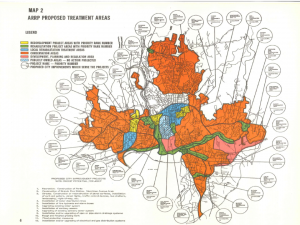“Downtown was still dying, still going down. It was pretty abandoned even then, but it got more abandoned…there was no place to eat, no place to live.”
– J Patrick “Pat” Whalen, Jr, Asheville resident (1976).[ref]Nan K. Chase, Asheville: A History (Jefferson, NC: McFarland &, 2007), 180-182.[/ref]

Turn of the century Asheville, NC was a city to behold. As Molly Sanger point’s out in her thesis The Mall That Almost Ate Asheville, legendary businessmen alongside a thriving community invested time, money and effort all over the city that lead to the prestige of the tiny mountain oasis. Franklin Coxe opened the Battery Park hotel in 1885 while the art deco architecture of 1920’s would come to dazzle downtown with rustic charm. Asheville even built it’s first skyscraper, the Jackson building, 1924. However, the rise to glorious heights would eventually serve only as more distance to fall from grace. Sager goes on to note that alongside private investment, public spending soared. By 1925, public debt hit $8,680,000. Debt continued to rise and in 1929, the stock market crashed and Asheville’s early 20th century success came screaming down with it. Economic crisis was ringing throughout the nation, with a deafening echo tearing through the mountains of North Carolina.[ref]Molly Sager, “The Mall That Almost Ate Asheville: The Fight between City Hall and Save Downtown Asheville Inc. Over the Strouse, Greenberg & Company Downtown Commercial Complex” (Undergraduate Thesis, University of North Carolina at Asheville, 2012), 6-8.[/ref] Sager also points out that the same Great Depression that would bring suffering to most of America would hit Asheville with even more force. The city was on the verge of bankruptcy with a debt that exceeded that of Raleigh, Durham, Winston-Salem, and Greensboro combined. To save the city, a restructuring plan was proposed in 1939 but it would not be until 1976 that the debt would be retired. The debt was paid in 1976 and Asheville city leaders were already looking forward, but the sight was not pretty. Years of crippling debt and economic downtown was had taken its toll on the city.[ref]Molly Sager, “The Mall That Almost Ate Asheville: The Fight between City Hall and Save Downtown Asheville Inc. Over the Strouse, Greenberg & Company Downtown Commercial Complex” ,7-8.[/ref]

According to theAsheville Rehabilitation and Renewal Program and Neighborhood Analysis, Asheville has had a plan for it’s growth since 1922; however, these plans did not come into action until 1958 when the Buncombe County Metropolitan Planning Board was formed . In June, 1973 the Planning Board released an extensive study that reveled the change in urban conditions since 1966.[ref]Metropolitan Planning Board- Asheville and Buncombe County. Phase I – Asheville Rehabilitation and Renewal Program and Neighborhood Analysis. PDF. Asheville: Metropolitan Planning Board, June 1973. 1.[/ref] The comparison showed that Asheville, like many other old cities, was suffering from various degrees of infrastructural deterioration and social decay. Asheville’s 1920’s water system was collapsing while fires, major crime, tuberculosis and venereal diseases were on the rise.[ref]Metropolitan Planning Board- Asheville and Buncombe County. Phase II – Asheville Rehabilitation and Renewal Program and Neighborhood Analysis. PDF. Asheville: Metropolitan Planning Board, June 1974. 18.[/ref] On top of that, residential housing along with commercial and industrial buildings had become increasingly dilapidated between 1966 and 1973. In 1974 city officials found the mall plan attractive because it offered an alternative to the long term city renewal cost of more than $100 million and shrinking tax base, Asheville city leaders were desperate for something to the pull the city out of ruin.[ref]Metropolitan Planning Board- Asheville and Buncombe County. Phase II, 17, 207.[/ref] The Asheville Rehabilitation and Renewal Program and Neighborhood Analysis justified the city’s proposal to build a mall that would reshape Downtown Asheville.[ref]Housing Authority of the City of Asheville, and City of Asheville, Division of Planning. Asheville Commercial Complex Redevelopment Plan. PDF. Asheville: City of Asheville, August 1981, i.[/ref]
